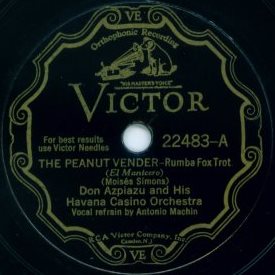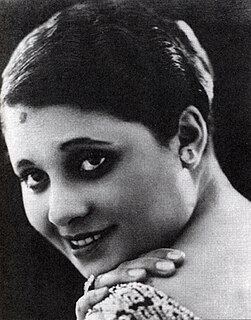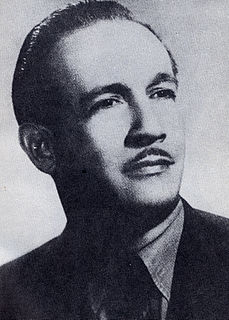Related Research Articles
Mambo is a genre of Cuban dance music pioneered by the charanga Arcaño y sus Maravillas in the late 1930s and later popularized in the big band style by Pérez Prado. It originated as a syncopated form of the danzón, known as danzón-mambo, with a final, improvised section, which incorporated the guajeos typical of son cubano. These guajeos became the essence of the genre when it was played by big bands, which did not perform the traditional sections of the danzón and instead leaned towards swing and jazz. By the late 1940s and early 1950s, mambo had become a "dance craze" in the United States as its associated dance took over the East Coast thanks to Pérez Prado, Tito Puente, Tito Rodríguez and others. In the mid-1950s, a slower ballroom style, also derived from the danzón, cha-cha-cha, replaced mambo as the most popular dance genre in North America. Nonetheless, mambo continued to enjoy some degree of popularity into the 1960s and new derivative styles appeared, such as dengue; by the 1970s it had been largely incorporated into salsa.
The music of Cuba, including its instruments, performance, and dance, comprises a large set of unique traditions influenced mostly by west African and European music. Due to the syncretic nature of most of its genres, Cuban music is often considered one of the richest and most influential regional music in the world. For instance, the son cubano merges an adapted Spanish guitar (tres), melody, harmony, and lyrical traditions with Afro-Cuban percussion and rhythms. Almost nothing remains of the original native traditions, since the native population was exterminated in the 16th century.
Son cubano is a genre of music and dance that originated in the highlands of eastern Cuba during the late 19th century. It is a syncretic genre that blends elements of Spanish and African origin. Among its fundamental Hispanic components are the vocal style, lyrical metre and the primacy of the tres, derived from the Spanish guitar. On the other hand, its characteristic clave rhythm, call and response structure and percussion section are all rooted in traditions of Bantu origin.
Ernesto Lecuona y Casado was a Cuban composer and pianist of worldwide fame. He composed over six hundred pieces, mostly in the Cuban vein, and was a pianist of exceptional skill. His father was Canarian and his mother was Cuban.

"El manisero", known in English as "The Peanut Vendor", is a Cuban son-pregón composed by Moisés Simons. Together with "Guantanamera", it is arguably the most famous piece of music created by a Cuban musician. "The Peanut Vendor" has been recorded more than 160 times, sold over a million copies of the sheet music, and was the first million-selling 78 rpm single of Cuban music.
"Para Vigo me voy", known in English as "Say Si Si", is a popular song written in 1935 by Cuban composer Ernesto Lecuona with lyrics by Francia Luban and Al Stillman. Early bands to record the song include Xavier Cugat's orchestra (1935) and Lecuona Cuban Boys (1937). The song was copyrighted in the United States in 1940. It became a hit in the US when it was recorded by The Andrews Sisters and Glenn Miller in 1940, and The Mills Brothers in 1953.

Rita Aurelia Fulcida Montaner y Facenda, known as Rita Montaner, was a Cuban singer, pianist and actress. In Cuban parlance, she was a vedette, and was well known in Mexico City, Paris, Miami and New York, where she performed, filmed and recorded on numerous occasions. She was one of Cuba's most popular artists between the late 1920s and 1950s, renowned as Rita de Cuba. Though classically trained as a soprano for zarzuelas, her mark was made as a singer of Afro-Cuban salon songs including "The Peanut Vendor" and "Siboney".
Early Cuban bands played popular music for dances and theatres during the period 1780–1930. During this period Cuban music became creolized, and its European and African origins gradually changed to become genuinely Cuban. Instrumentation and music continually developed during this period. The information listed here is in date order, and comes from whatever records survive to the present day.
Cuban musical theatre has its own distinctive style and history. From the 18th century to modern times, popular theatrical performances included music and often dance as well. Many composers and musicians had their careers launched in the theatres, and many compositions got their first airing on the stage. In addition to staging some European operas and operettas, Cuban composers gradually developed ideas which better suited their creole audience. Characters on stages began to include elements from Cuban life, and the music began to reflect a fusion between African and European contributions.
José Pablo Valenzuela García was a leading Cuban cornetist, composer and bandleader.

Eliseo Grenet Sánchez was a Cuban pianist and a leading composer/arranger of the day. He composed music for stage shows and films, and some famous Cuban dance music. Eliseo was one of three musical brothers, all composers, the others being Emilio and Ernesto (1908–1981). Emilio went on composing even after having a leg bitten off by a shark in 1930; Ernesto was a drummer who became leader of the Tropicana's orchestra.

Moisés Simons, was a leading Cuban composer, pianist, and orchestra leader. He was the composer of El Manisero which is considered by many to be the most famous piece of music created by a Cuban musician and has since been recorded by other musicians from around the world hundreds of times.

Orlando Guerra, better known as Cascarita, was a popular Cuban singer who specialized in guaracha and son montuno. He became one of Cuba's most famous vocalists as a member of Julio Cueva's big band and Orquesta Casino de la Playa in the 1940s.

Ernestina Lecuona y Casado was a Cuban pianist, music educator and composer.
Obdulio Morales Ríos was a Cuban pianist, conductor, composer and ethnomusicologist, an important figure in the late afrocubanismo movement. He championed Afro-Cuban music traditions and sponsored artists such as Merceditas Valdés.
Raimunda Paula Peña Álvarez, better known as Paulina Álvarez, was a renowned Cuban singer of danzonetes. She became the leading exponent of the genre during the 1930s, being nicknamed La Emperatriz del Danzonete. Her greatest hit was the song "Rompiendo la rutina", the first danzonete, composed by Aniceto Díaz in 1929. In 1960 she recorded her only LP record.
Francisco Emilio Flynn Rodríguez, better known as Frank Emilio Flynn, was a renowned Cuban pianist. Despite being blind, he was a skilled and versatile pianist who mastered many forms of Cuban music, from danzas and danzones to filin, descarga and Afro-Cuban jazz. He was the founder and director of several ensembles, including Loquibambia (1946) and Los Modernistas (1951), both co-founded with José Antonio Méndez, as well as the Quinteto Instrumental de Música Moderna (1958), which later became Los Amigos.
Puchito Records was Cuba's second independent record label. It was founded in 1954 during the mambo and cha-cha-chá explosion. Many of its recordings, produced by its founder Jesús Gorís, became instant hits.
Puchito Records was Cuba's second independent record label. It was founded in 1954 during the mambo and cha-cha-chá explosion of the 1950s. Many of its recordings, produced by its founder Jesús Gorís (1921–2006), became instant hits. Cuban music styles represented in its discography include danzón, güajira, son cubano, son montuno, cha-cha-chá, guaracha, guaguancó, Cuban bolero, Cuban rumba, mambo, new flamenco, and Zarzuela. Other styles include farruca, merengue (Dominican), Ranchera (Mexican), nueva canción (Mexican) ... styles from Spain include cuplé, pasodoble, and flamenco. The ensembles range from studio orchestras to jazz combos to big bands to charangas.
Juana Coralia López Valdés was a Cuban pianist, bandleader and composer. Between 1940 and 1956 she directed her own charanga danzonera, being the first woman to direct any such orchestra in Cuba. During her career she composed many popular danzones such as "Llegó Manolo", "El bajo que come chivo", "Los jóvenes del agua fria" and the famous "Isora Club", which became a standard in the Latin music repertoire.